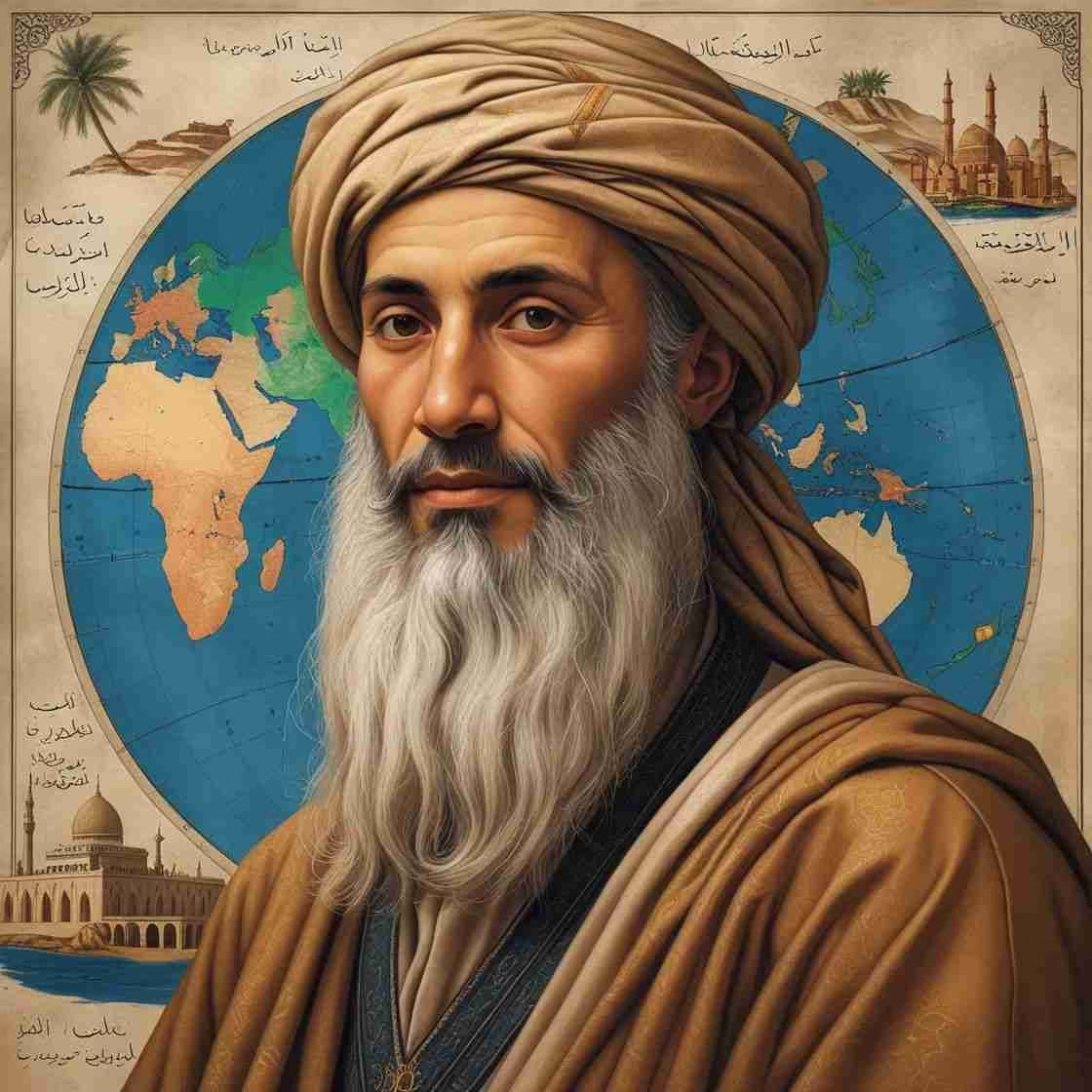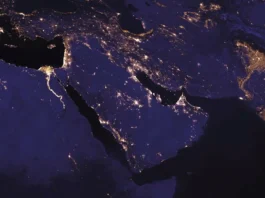Introduction: A Traveler Beyond Imagination
In 1325, a 21-year-old Moroccan scholar set out from Tangier with one goal: to complete the Hajj pilgrimage. What followed would become the longest overland journey in human history until the 19th century spanning 75,000 miles, 40 modern countries, and three continents over 29 years. His name? Ibn Battuta, the medieval Muslim explorer whose extraordinary travels would far surpass those of the more famous Marco Polo.

Today, Marco Polo is a household name in the West, but Ibn Battuta traveled farther, saw more, and chronicled a world far richer and more interconnected than many realize. His journey is not just about distance it’s a profound look at human civilization through the eyes of one of history’s most relentless explorers, whose travel manuscript The Rihla provides us with invaluable insights into the medieval Islamic world and beyond.
A Journey Born of Faith and Curiosity
Ibn Battuta was born in 1304 in Tangier, Morocco, into a family of Islamic judges. As a young man educated in Islamic law, he set out on what was supposed to be a pilgrimage to Mecca. Instead, it turned into a lifelong odyssey. He left home at age 21, never to see his parents again, a detail that humanizes the magnitude of his travels.
Equipped with nothing but determination and a thirst for knowledge, he navigated deserts, crossed mountains, sailed oceans, and trekked through jungles. Unlike today’s tourists, he didn’t carry a camera or travel insurance, he relied on the goodwill of strangers, Islamic hospitality networks, and his knowledge of the Quran to survive.

He traveled by foot, camel, dhow, and horseback, often joining merchant caravans or diplomatic missions. But it was more than logistics it was a divine calling. As a devout Muslim, Ibn Battuta sought knowledge, justice, and truth in the farthest corners of the Islamic world and beyond, demonstrating how medieval travel networks connected distant lands long before the modern era.
What Made His Travels Extraordinary?
Most people compare him to Marco Polo, but the comparison falls short in many ways:
- Distance Covered: Ibn Battuta traveled over 75,000 miles three times the distance of Marco Polo.
- Cultural Reach: While Polo focused on Mongol ruled China, Ibn Battuta immersed himself in nearly every major Muslim kingdom and even ventured into non-Muslim regions.
- Length of Journey: He was on the road for nearly 30 years.
- Roles Played: He wasn’t just a traveler he was a judge, a diplomat, and even a prisoner.

His travels took him across North Africa, the Middle East, East and West Africa, Central Asia, India, the Maldives, Southeast Asia, and possibly even China. These weren’t quick stopovers—he often stayed for months or even years, building relationships and serving in governmental or judicial roles. This unique aspect of Ibn Battuta’s role as judge in foreign kingdoms provides us with insider perspectives few travelers could access.
The Cities He Documented That No Longer Exist
Many of the forgotten cities documented by Ibn Battuta have either drastically changed or disappeared:
- Kilwa (Tanzania): A wealthy Swahili port city described as having grand stone houses and mosques built from coral rock.
- Timbuktu (Mali): A global center of learning and trade, home to one of the richest libraries in the world at the time.
- Delhi (India): The capital of the brutal Sultan Muhammad bin Tughluq, where Battuta served as chief judge.
- Samudra (Sumatra): A powerful trading kingdom in Indonesia where Ibn Battuta encountered Buddhist and Hindu cultures living alongside Muslims.
Through his writings, we now have the only surviving descriptions of some of these places. His memoir, The Rihla, captures the vibrancy, the dangers, and the diversity of the 14th-century world, making The Rihla’s historical significance today impossible to overstate.
Surviving Near-Death Encounters
His journey wasn’t glamorous. How Ibn Battuta survived 29 years of travel is a testament to his resilience and adaptability. He faced storms at sea, bandit attacks, political purges, and shipwrecks. While serving in India, he found himself imprisoned by the very sultan he worked under. Later in the Maldives, he narrowly escaped execution thanks to the intervention of a royal wife. His journey across Africa’s deserts pushed him to the brink, as he battled dehydration and deadly sandstorms.

Despite this, he pressed on, interpreting each survival as a sign of divine favor. He was once stranded alone after pirates stole everything. Another time, a disease outbreak decimated his caravan, and he buried companions with his own hands. Each challenge was met with unwavering faith, and these near-death experiences of Ibn Battuta became integral parts of his narrative.
The Influence of Islam on His Travels
Islam played a crucial role in enabling his journey. The shared language (Arabic), religious practices, and educational institutions of the Islamic world formed a kind of medieval passport system. Mosques provided lodging, and scholars offered guidance. Wherever he went, he found a sense of belonging among Muslims even in far-off China.
But Ibn Battuta also documented theological tensions, such as Sunni-Shia divides, heretical sects, or syncretic practices that shocked his orthodox sensibilities. How Ibn Battuta’s faith helped his travels is a fascinating study in how religion could facilitate global mobility in the pre-modern world. His observations give historians invaluable insight into how Islam adapted and manifested differently across regions during the Islamic Golden Age.
Reaching the Edges of the Known World
Ibn Battuta’s travels even took him beyond the Islamic world:
- China: Though historians debate whether he reached Beijing, he described paper money, vast canals, and multicultural cities accurately.
- The Byzantine Empire: He visited Constantinople before its fall, describing its churches, rulers, and customs.
- Sub-Saharan Africa: He joined caravans across the Sahara to visit Mali’s king, remarking on the empire’s wealth and justice system.
Ibn Battuta’s observations of different cultures provide a unique window into medieval societies that few other sources can match. His descriptions of medieval Mali remain some of the most valuable firsthand accounts of this powerful West African empire at its height.
The Rihla: A Masterpiece of Global Journalism
When Ibn Battuta finally returned to Morocco in 1354, Sultan Abu Inan ordered him to dictate his travels to a scribe named Ibn Juzayy. The result was The Rihla part travelogue, part ethnography, part diary.

It’s more than a book it’s a time capsule. The Rihla Ibn Battuta travel manuscript records:
- The only eyewitness account of the post-Mansa Musa Mali Empire
- Descriptions of forgotten African kingdoms
- Early observations of Southeast Asian trade
- Discussions of politics, gender roles, food, and education in dozens of societies
It remains one of the richest sources for 14th-century history, though it was largely unknown in the West until its translation in the 20th century. How Ibn Battuta changed historical geography through his detailed accounts cannot be overstated he mapped a world far more complex and interconnected than European sources suggested.
Ibn Battuta vs. Marco Polo: Who Was the Greatest Explorer?
Western audiences often celebrate Marco Polo, but why Ibn Battuta is less famous than Marco Polo remains a puzzling historical oversight. Ibn Battuta traveled farther, visited more cultures, and held official positions in more kingdoms.

| Aspect | Ibn Battuta | Marco Polo |
|---|---|---|
| Distance Traveled | 75,000+ miles | ~24,000 miles |
| Time Spent Traveling | 29 years | 24 years |
| Areas Visited | Africa, Asia, Europe | Mainly Asia |
| Official Roles Held | Judge, Ambassador, Scholar | Merchant, Advisor |
The comparison isn’t a contest, but it raises a question: Why isn’t Ibn Battuta a household name?
Perhaps now is the time to change that.
Why Isn’t Ibn Battuta a Household Name?
Despite his astonishing journey, Ibn Battuta is often overshadowed by European explorers. There are several reasons:
- Colonial Historiography: European schools prioritized explorers like Columbus and Polo, ignoring Muslim scholars.
- Lack of Western Promotion: Unlike Polo, who had his story edited by a romantic novelist while in prison, Ibn Battuta had no Western promoters.
- Late Translation: His work wasn’t widely accessible in English or French until the 1900s.
But the tide is turning. More scholars, filmmakers, and educators are now rediscovering his contributions to our understanding of the medieval Islamic travel networks that connected distant civilizations.
Legacy in the Modern World
Today, Ibn Battuta’s influence is slowly gaining the recognition it deserves:
- UNESCO has developed educational trails to retrace his steps.
- Dubai’s Ibn Battuta Mall celebrates his legacy with themed sections representing regions he visited.
- Academic programs and documentaries are now incorporating his journey as a foundation for global studies.

His story reminds us that exploration, cultural exchange, and global networks aren’t modern phenomena they’ve shaped our world for centuries. By understanding Ibn Battuta’s journeys, we gain a more accurate picture of our interconnected past.
Final Thoughts: The Man Who Walked the Earth
Ibn Battuta wasn’t driven by conquest or trade, but by faith and a hunger to understand. He listened, observed, questioned, and recorded a world on the brink of major transformation. While empires rose and fell, and kingdoms disappeared, his journey endured in ink.
In many ways, he was the original global citizen curious, adaptable, and driven by purpose.
If Marco Polo showed Europe a slice of Asia, Ibn Battuta captured the pulse of the entire known world.
“He proved that borders are illusions, and curiosity is the strongest passport.”
Frequently Asked Questions
Q: How did Ibn Battuta finance his 29 years of travel across three continents?
A: Unlike modern travelers who need savings or sponsorships, Ibn Battuta relied on a sophisticated network of Islamic institutions and patronage. As an educated Islamic legal scholar, he benefited from the Muslim tradition of hospitality toward travelers, receiving food and lodging at mosques and religious schools. More importantly, his expertise in Islamic law made him valuable to rulers across the Muslim world, who appointed him to positions as a qadi (judge) or diplomat, providing him with salaries, gifts, and protection. In India, he served the Sultan of Delhi for several years, receiving substantial compensation. When traveling between Muslim lands, he often joined merchant caravans or diplomatic missions for safety and logistical support. This combination of religious hospitality, professional appointments, and strategic travel planning enabled his unprecedented journey without personal wealth.
Q: What makes Ibn Battuta’s account of medieval Mali so historically significant?
A: Ibn Battuta’s detailed description of the Mali Empire (1230-1600) provides the only comprehensive eyewitness account of this powerful West African kingdom at its height. His observations of Mali’s sophisticated legal system, where even the king submitted to justice, challenged European assumptions about African governance. He documented Mali’s extensive gold trade, monetary system, and the famous university city of Timbuktu when it was a global center of learning. Most importantly, his account confirms that sub-Saharan Africa was fully integrated into medieval global networks of trade, scholarship, and diplomacy contradicting later colonial narratives that portrayed the region as isolated or undeveloped. His descriptions of the Mali ruler’s court ceremonies, justice system, and diplomatic protocols provide irreplaceable primary source material for historians reconstructing this powerful kingdom that controlled much of West Africa’s gold trade and significantly influenced world economics.
Q: Who was Ibn Battuta and why is he important?
A: Ibn Battuta was a 14th-century Moroccan scholar and explorer who traveled over 75,000 miles across 40 modern countries during a 29-year journey (1325-1354). Originally setting out to complete the Hajj pilgrimage to Mecca, he continued traveling throughout Africa, Asia, and parts of Europe, serving as a judge in various kingdoms and documenting his observations in a travel memoir called ‘The Rihla.’ His importance stems from providing unique firsthand accounts of numerous medieval societies, many of which have since disappeared or dramatically changed. His writings offer invaluable insights into the interconnected nature of the medieval world, challenging Eurocentric historical narratives and revealing sophisticated networks of trade, scholarship, and cultural exchange spanning three continents. As the most extensive pre-modern traveler whose journey is documented in detail, he represents a crucial primary source for understanding global history before European colonial expansion.
Q: How does Ibn Battuta compare to Marco Polo?
A: Ibn Battuta traveled approximately three times farther than Marco Polo (75,000 miles compared to 24,000), visited more countries (40 compared to 15), and spent more time traveling (29 years compared to 24). While Marco Polo focused primarily on China and the Mongol Empire, Ibn Battuta traveled extensively throughout Africa, the Middle East, and Asia, immersing himself in diverse cultures and serving in official capacities as a judge and diplomat in various kingdoms. Unlike Polo, who primarily observed as a merchant, Ibn Battuta participated directly in the governance and legal systems of the places he visited. Despite these more extensive accomplishments, Ibn Battuta remains less known in Western societies due to historical biases in education, the later translation of his works into European languages, and the lack of promotion his narrative received compared to Polo’s romanticized account.
Q: What is The Rihla and why is it important?
A: The Rihla (meaning ‘journey’ in Arabic) is Ibn Battuta’s travel memoir, dictated to a scholar named Ibn Juzayy in 1354-1355. Its formal title is ‘A Gift to Those Who Contemplate the Wonders of Cities and the Marvels of Traveling.’ It’s historically significant because it provides detailed firsthand accounts of many medieval societies, including some that have since disappeared. The Rihla contains unique observations about political systems, trade networks, cultural practices, and geographical features across Africa, the Middle East, and Asia during the 14th century. As one of the most comprehensive travel accounts from the pre-modern era, it serves as an invaluable primary source for historians studying global interconnections, cultural exchange, and everyday life across three continents before European colonial expansion. The work also demonstrates the extensive nature of medieval travel networks and the cosmopolitan character of the Islamic world during this period.
Explore More:
📖 [Full Rihla Translation – Princeton Library]
🗺️ [Ibn Battuta: around the world in thirty years – UNESCO]
📺 [Watch the BBC Documentary The Man Who Walked the World]
📢 Share this article to #RediscoverIbnBattuta
✈️ Let the world know who really walked the Earth.





It is very interesting. It is hightime that we are aware of others other than western ones. We miss partly because of their inadequate exposure and partly prejudices. Personally, I like that more such exposures. While reading about Indian sultanate, there is just a mention of Ibn Batuta and nothing more. His observations will be useful.